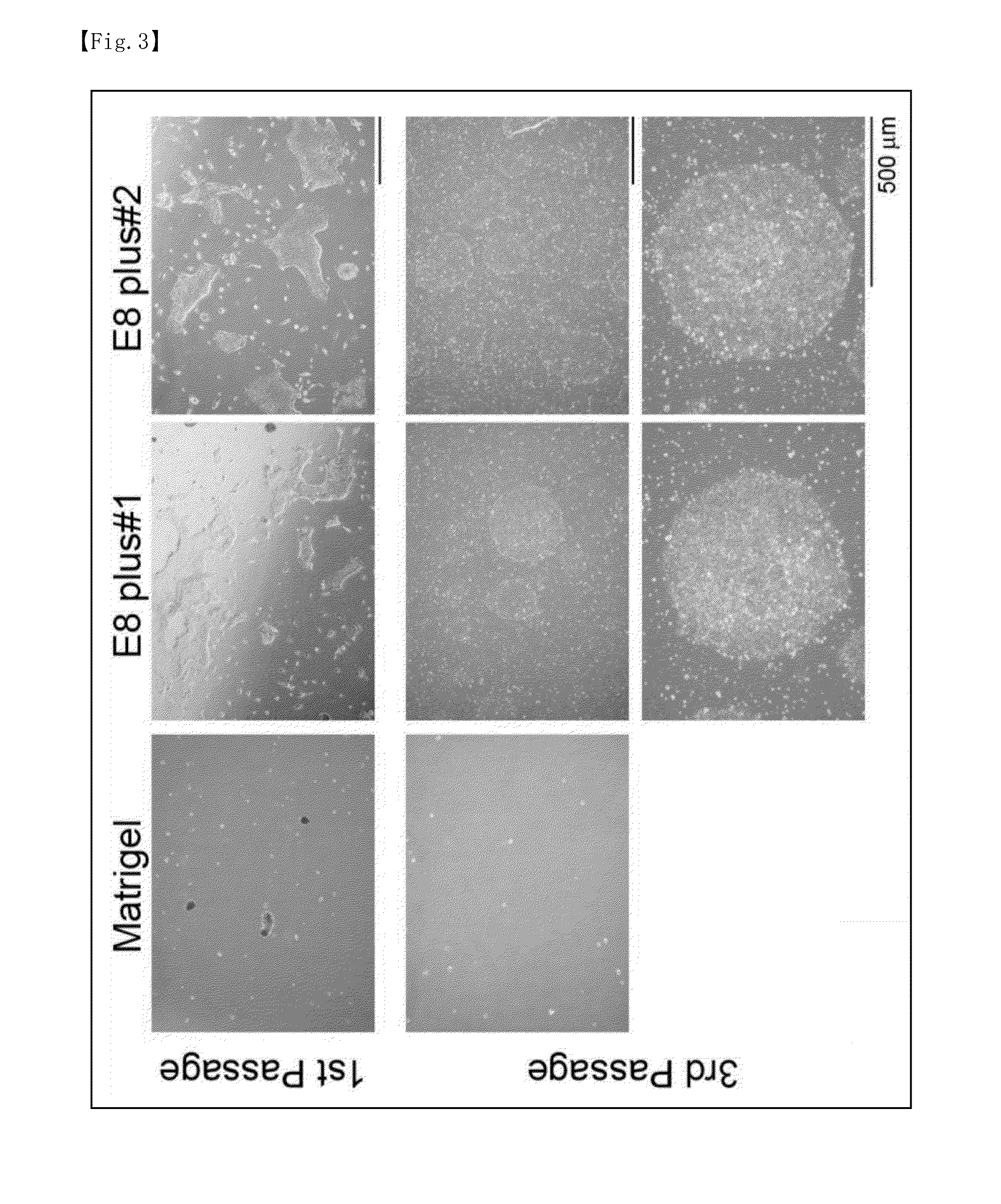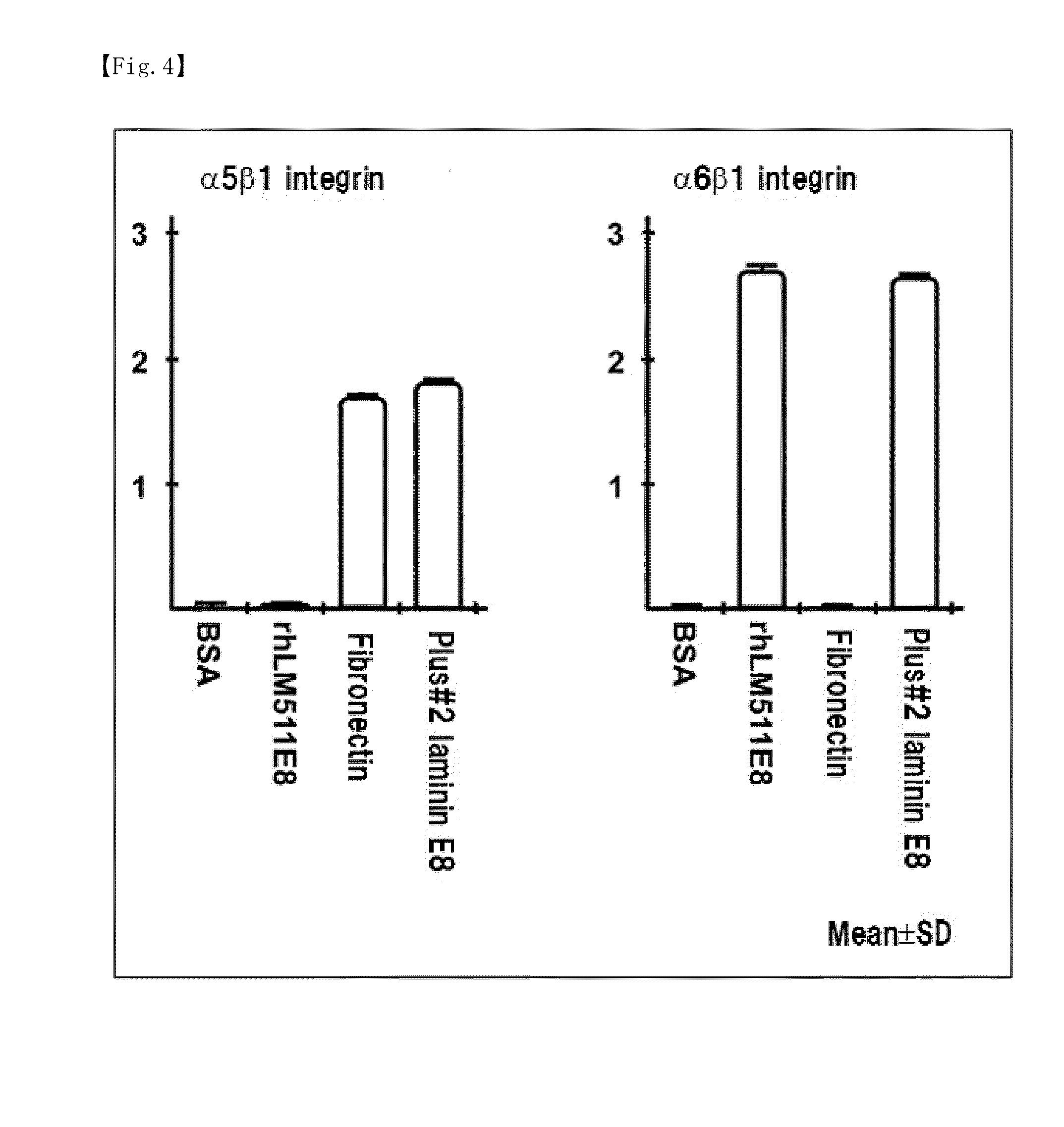Modified laminin and use thereof
a technology of human laminin and modified laminin, which is applied in the field of modified human laminin, can solve the problems of poor quality, safety, and inability to maintain the undifferentiated state of human stem cells, and achieve the effect of high-quality human stem cells
- Summary
- Abstract
- Description
- Claims
- Application Information
AI Technical Summary
Benefits of technology
Problems solved by technology
Method used
Image
Examples
example 1
Preparation of Modified Human Laminin
(1) Preparation of Expression Vector for Plus#1 Laminin E8
[0093]For preparation of Plus#1 laminin E8 (a modified human laminin in which the 4th and 5th globular domains of the human laminin α1 chain are fused with the E8 fragment of recombinant human laminin α5β1γ1), recombinant human laminin 511E8 (hereinafter referred to as “rhLM511E8”) was first prepared, and then to the C-terminal region of the human laminin α5 chain E8, the 4th and 5th globular domains of the human laminin α1 chain (hereinafter referred to as “human laminin α1 chain LG45”) were added.
(1-1) Construction of Expression Vectors for Human Laminin α5, β1 and γ1 Chain E8 Fragments
[0094]rhLM511E8 was prepared according to the method of Ido et α1. (Hiroyuki Ido, Aya Nakamura, Reiko Kobayashi, Shunsuke Ito, Shaoliang Li, Sugiko Futaki, and Kiyotoshi Sekiguchi, “The requirement of the glutamic acid residue at the third position from the carboxyl termini of the laminin γ chains in integ...
example 2
Comparison of Coating Concentration-Dependent Adhesion Efficiencies of Human iPS Cells on Various Extracellular Matrices
(1) Human iPS Cells
[0111]The human iPS cells used were a cell line (clone name: tic (JCRB1331)) purchased from Japanese Collection of Research Bioresources, the National Institute of Biomedical Innovation. The tic cells were maintained on mouse feeder cells according to the method recommended by Japanese Collection of Research Bioresources, the National Institute of Biomedical Innovation. To the co-culture dish, 1 U / ml dispase / DMEM-F12 was added and tic cell colonies were harvested with a scraper. The solution containing the tic cell colonies and the mouse feeder cells was filtered through a BD Falcon 100-μm cell strainer, and the cell strainer was washed. As a result, the tic cell colonies were separated. The colonies remaining in the cell strainer were collected in a xeno-free culture medium TeSR2 (trade name, STEMCELL TECHNOLOGIES), split into smaller colonies w...
example 3
Passage Culture of Human iPS Cells on Culture Substrates Coated with Various Extracellular Matrices (I)
(1) Human iPS Cells
[0115]The human iPS cells used were 32R1 cells (Masato Nakagawa, Nanako Takizawa, Megumi Narita, Tomoko Ichisaka, Shinya Yamanaka, “Promotion of direct reprogramming by transformation-deficient Myc.”, Proceedings of the National Academy of Sciences, 107 (32), 14152-14157, 2010). The 32R1 cells were maintained on MSTO mouse feeder cells (Kazutoshi Takahashi, Koji Tanabe, Mari Ohnuki, Megumi Narita, Tomoko Ichisaka, Kiichiro Tomoda, Shinya Yamanaka, “Induction of pluripotent stem cells from adult human fibroblasts by defined factors.”, Cell, 131 (5), 861-872, 2007).
(2) Extracellular Matrices
[0116]The extracellular matrices used were Plus#1 laminin E8, Plus#2 laminin E8, and Matrigel. For coating with Plus#1 laminin E8 and Plus#2 laminin E8, a Plus#1 laminin E8 solution and a Plus#2 laminin E8 solution were separately diluted with phosphate-buffered physiological sa...
PUM
| Property | Measurement | Unit |
|---|---|---|
| molecular weight | aaaaa | aaaaa |
| molecular weight | aaaaa | aaaaa |
| length | aaaaa | aaaaa |
Abstract
Description
Claims
Application Information
 Login to View More
Login to View More - R&D
- Intellectual Property
- Life Sciences
- Materials
- Tech Scout
- Unparalleled Data Quality
- Higher Quality Content
- 60% Fewer Hallucinations
Browse by: Latest US Patents, China's latest patents, Technical Efficacy Thesaurus, Application Domain, Technology Topic, Popular Technical Reports.
© 2025 PatSnap. All rights reserved.Legal|Privacy policy|Modern Slavery Act Transparency Statement|Sitemap|About US| Contact US: help@patsnap.com



